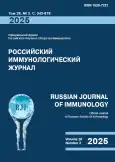Evaluation of changed metabolite profiles in SIM-A9 microglial cells under the influence of hypoxia and lipopolysaccharide
- Authors: Bobrov M.Y.1, Nikitin V.S.1, Burak M.Y.1, Afonin M.B.1
-
Affiliations:
- Sirius University of Science and Technologies
- Issue: Vol 28, No 3 (2025)
- Pages: 553-560
- Section: SHORT COMMUNICATIONS
- URL: https://journal-vniispk.ru/1028-7221/article/view/319900
- DOI: https://doi.org/10.46235/1028-7221-17212-EOC
- ID: 319900
Cite item
Full Text
Abstract
Microglial cells play a leading role in development of neuroinflammation. Activation of microglia leads to the formation of reactive phenotypes that can both contribute to the development of neuroinflammation and ensure its relief. Microglia activation is accompanied by metabolic reprogramming or changes in the metabolic pathways activity and the content of specific metabolites supporting a particular phenotype. An opportunity of phenotype switching due to metabolomic reprogramming may have real therapeutic potential. However, currently there are limited data on changes in composition of metabolites and activity of metabolic pathways in microglial cells under the influence of neuroinflammatory factors. In this regard, the purpose of this work was to conduct a non-targeted metabolomic study to assess changes of metabolites profiles in microglial cell line SIM-A9 exposed to hypoxia, as well as during TLR4 activation. Metabolite profiling of cell extracts exposed to hypoxia or lipopolysaccharide was performed using high-performance liquid chromatography and high-resolution mass spectrometry, followed by bioinformatics analysis of the data. The performed studies have shown that hypoxia, as well as TLR4 stimulation, lead to noticeable changes in the metabolism of microglial cells. At the same time, the nature of these changes depends on the type of stress exposure and its duration. Changed activity of glutathione and arginine metabolic pathways may serve as a marker of the polarization of microglial cells after hypoxic exposure. The activation of TLR4 by lipopolysaccharide leads to modulation of pathways associated with energy metabolism, as well as changes in the metabolic pathways of aromatic amino acids. One may suggest that the analytic approach used in this work will allow us to further investigate the dynamics of metabolic changes under the influence of proinflammatory factors of various origin and to gain detailed data on their role in metabolic reprogramming of microglial cells at various stages of neuroinflammation.
Full Text
##article.viewOnOriginalSite##About the authors
Mikhail Yu. Bobrov
Sirius University of Science and Technologies
Author for correspondence.
Email: bobrov.my@talantiuspeh.ru
PhD (Сhemistry), Leading Researcher in the Field of “Immunobiology and biomedicine”, Scientific Center of Genetics and Life Sciences
Russian Federation, Sirius settlement, Krasnodar RegionV. S. Nikitin
Sirius University of Science and Technologies
Email: bobrov.my@talantiuspeh.ru
Laboratory Research Assistant, Master’s Student (Immunobiology and Biomedicine)
Russian Federation, Sirius settlement, Krasnodar RegionM. Yu. Burak
Sirius University of Science and Technologies
Email: bobrov.my@talantiuspeh.ru
Laboratory Research Assistant, Master’s Student (Immunobiology and Biomedicine)
Russian Federation, Sirius settlement, Krasnodar RegionM. B. Afonin
Sirius University of Science and Technologies
Email: bobrov.my@talantiuspeh.ru
Chief Research Engineer, Resource Center for Analytical Methods
Russian Federation, Sirius settlement, Krasnodar RegionReferences
- Chen B., Di B. Endogenous Ligands of TLR4 in microglia: potential targets for related neurological diseases. Curr. Drug Targets, 2024, Vol. 25, no. 14, pp. 953-970.
- Fan H., Bai Q., Yang Y., Shi X., Du G., Yan J., Shi J., Wang D. The key roles of reactive oxygen species in microglial inflammatory activation: Regulation by endogenous antioxidant system and exogenous sulfur-containing compounds. Eur. J. Pharmacol., 2023, Vol. 956, 175966. doi: 10.1016/j.ejphar.2023.175966.
- Hestad K., Alexander J., Rootwelt H., Aaseth J.O. The role of tryptophan dysmetabolism and quinolinic acid in depressive and neurodegenerative diseases. Biomolecules, 2022, Vol. 12, no. 7, 998. doi: 10.3390/biom12070998.
- Iskusnykh I.Y., Zakharova A.A., Pathak D. Glutathione in brain disorders and aging. Molecules, 2022, Vol. 27, no. 1, 324. doi: 10.3390/molecules27010324.
- Li S., Park Y., Duraisingham S., Strobel F.H., Khan N., Soltow Q.A., Jones D.P., Pulendran B. Predicting network activity from high throughput metabolomics. PLoS Comput. Biol., 2013, Vol 9, no. 7, e1003123. doi: 10.1371/journal.pcbi.1003123.
- Liu Y., Wu L., Peng W., Mao X. Glial polarization in neurological diseases: Molecular mechanisms and therapeutic opportunities. Ageing Res. Rev., 2025, Vol. 104, 102638. doi: 10.1016/j.arr.2024.102638.
- Nair S., Sobotka K.S., Joshi P., Gressens P., Fleiss B., Thornton C., Mallard C., Hagberg H. Lipopolysaccharide-induced alteration of mitochondrial morphology induces a metabolic shift in microglia modulating the inflammatory response in vitro and in vivo. Glia, 2019, Vol. 67, no. 6, pp. 1047-1061.
- Ock J., Jeong J., Choi W.S., Lee W.H., Kim S.H., Kim I.K., Suk K. Regulation of Toll-like receptor 4 expression and its signaling by hypoxia in cultured microglia. J. Neurosci. Res., 2007, Vol. 85, pp. 1989-1995.
- Rana A.K., Bhatt B., Gusain C., Biswal S.N., Das D., Kumar M. Neuroimmunometabolism: how metabolism orchestrates immune response in healthy and diseased brain. Am. J. Physiol. Endocrinol. Metab., 2025, Vol. 328, no. 2, pp. E217-E229.
- Tyrtyshnaia A, Konovalova S, Bondar A, Ermolenko E, Sultanov R, Manzhulo I. Anti-inflammatory activity of N-Docosahexaenoylethanolamine and N-eicosapentaenoylethanolamine in a mouse model of lipopolysaccharide – induced neuroinflammation. Int. J. Mol. Sci., 2021, Vol. 22, no. 19, 10728. doi: 10.3390/ijms221910728.
- Wang Y., Leak R.K., Cao G. Microglia-mediated neuroinflammation and neuroplasticity after stroke. Front. Cell. Neurosci., 2022, Vol. 16, 980722. doi: 10.3389/fncel.2022.980722.
- Wang Z., Zhu H., Xiong W. Advances in mass spectrometry-based multi-scale metabolomic methodologies and their applications in biological and clinical investigations. Sci. Bull. (Beijing), 2023, Vol. 68, no. 19, pp. 2268-2284.
- Yang S., Qin C., Hu Z.W., Zhou L.Q., Yu H.H., Chen M., Bosco D.B., Wang W., Wu L.J., Tian D.S. Microglia reprogram metabolic profiles for phenotype and function changes in central nervous system. Neurobiol. Dis., 2021, Vol. 152, 105290. doi: 10.1016/j.nbd.2021.105290.
- Yao L., Kan E.M., Lu J., Hao A., Dheen S.T., Kaur C., Ling E.A. Toll-like receptor 4 mediates microglial activation and production of inflammatory mediators in neonatal rat brain following hypoxia: role of TLR4 in hypoxic microglia. J. Neuroinflammation, 2013, Vol. 10, 23. doi: 10.1186/1742-2094-10-23.
Supplementary files








